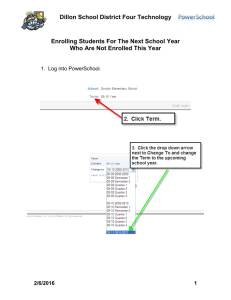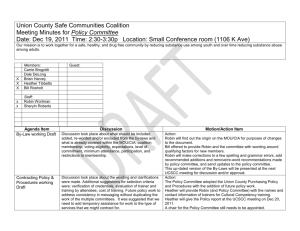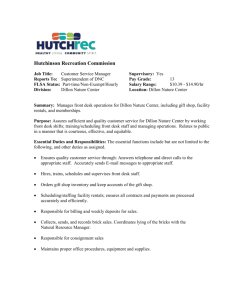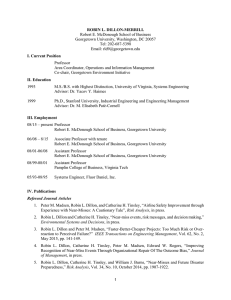ROBIN L
advertisement
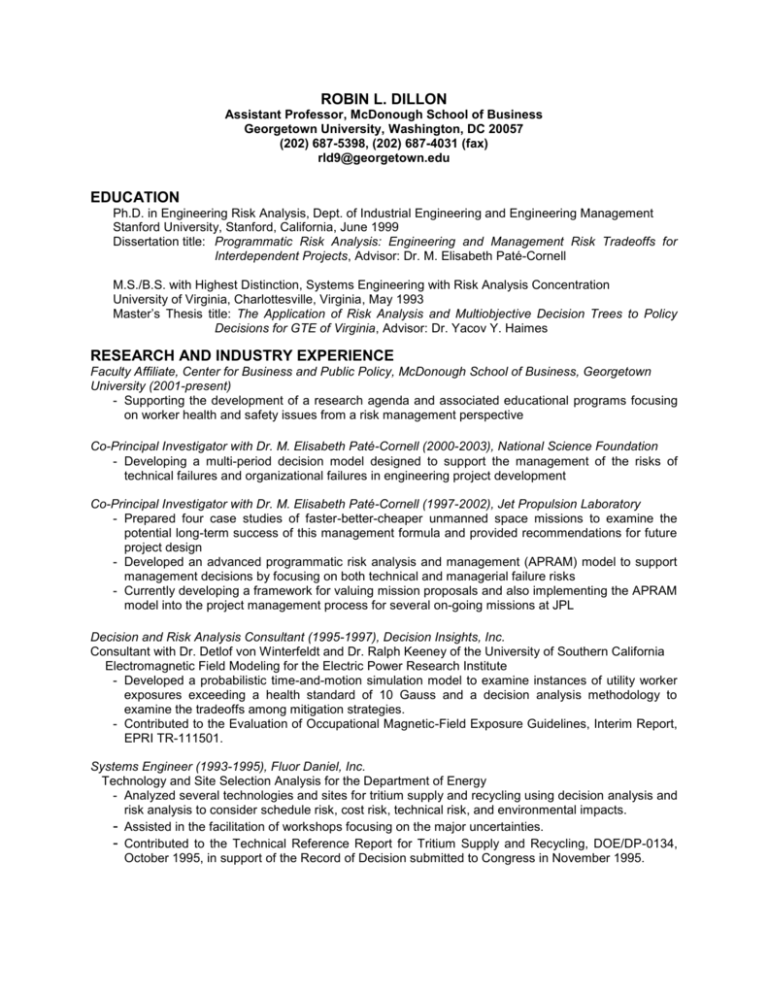
ROBIN L. DILLON Assistant Professor, McDonough School of Business Georgetown University, Washington, DC 20057 (202) 687-5398, (202) 687-4031 (fax) rld9@georgetown.edu EDUCATION Ph.D. in Engineering Risk Analysis, Dept. of Industrial Engineering and Engineering Management Stanford University, Stanford, California, June 1999 Dissertation title: Programmatic Risk Analysis: Engineering and Management Risk Tradeoffs for Interdependent Projects, Advisor: Dr. M. Elisabeth Paté-Cornell M.S./B.S. with Highest Distinction, Systems Engineering with Risk Analysis Concentration University of Virginia, Charlottesville, Virginia, May 1993 Master’s Thesis title: The Application of Risk Analysis and Multiobjective Decision Trees to Policy Decisions for GTE of Virginia, Advisor: Dr. Yacov Y. Haimes RESEARCH AND INDUSTRY EXPERIENCE Faculty Affiliate, Center for Business and Public Policy, McDonough School of Business, Georgetown University (2001-present) - Supporting the development of a research agenda and associated educational programs focusing on worker health and safety issues from a risk management perspective Co-Principal Investigator with Dr. M. Elisabeth Paté-Cornell (2000-2003), National Science Foundation - Developing a multi-period decision model designed to support the management of the risks of technical failures and organizational failures in engineering project development Co-Principal Investigator with Dr. M. Elisabeth Paté-Cornell (1997-2002), Jet Propulsion Laboratory - Prepared four case studies of faster-better-cheaper unmanned space missions to examine the potential long-term success of this management formula and provided recommendations for future project design - Developed an advanced programmatic risk analysis and management (APRAM) model to support management decisions by focusing on both technical and managerial failure risks - Currently developing a framework for valuing mission proposals and also implementing the APRAM model into the project management process for several on-going missions at JPL Decision and Risk Analysis Consultant (1995-1997), Decision Insights, Inc. Consultant with Dr. Detlof von Winterfeldt and Dr. Ralph Keeney of the University of Southern California Electromagnetic Field Modeling for the Electric Power Research Institute - Developed a probabilistic time-and-motion simulation model to examine instances of utility worker exposures exceeding a health standard of 10 Gauss and a decision analysis methodology to examine the tradeoffs among mitigation strategies. - Contributed to the Evaluation of Occupational Magnetic-Field Exposure Guidelines, Interim Report, EPRI TR-111501. Systems Engineer (1993-1995), Fluor Daniel, Inc. Technology and Site Selection Analysis for the Department of Energy - Analyzed several technologies and sites for tritium supply and recycling using decision analysis and risk analysis to consider schedule risk, cost risk, technical risk, and environmental impacts. - Assisted in the facilitation of workshops focusing on the major uncertainties. - Contributed to the Technical Reference Report for Tritium Supply and Recycling, DOE/DP-0134, October 1995, in support of the Record of Decision submitted to Congress in November 1995. ROBIN L. DILLON page 2 TEACHING EXPERIENCE Assistant Professor of Operations and Information Management (OPIM) McDonough School of Business, Georgetown University, August 2001-present Assistant Professor of Management Science and Information Technology Pamplin College of Business, Virginia Tech, August 1999-August 2001 Program Director and Lecturer in Advanced Project Management Executive Short Courses Stanford/IPS Advanced Project Management Mastery Certificate Program, June 21-23, 2000, and September 16-18, 2003, Stanford, California. Graduate Assistant, Stanford University - Supervisor, “Industrial Engineering Senior Project Course”, supervised three student groups in 1997 and 1998. In 1998, one group won the department’s outstanding project competition. - Graduate Mentor, Freshman Advising and Mentoring Program, 1998-1999 - Teaching Assistant, “Engineering Economy”, Winter 1996 and Fall 1997 PROFESSIONAL ORGANIZATIONS INFORMS member Decision Analysis Society Council, 2000-2002, Treasurer 2002-2004 Decision Analysis Track co-chair for INFORMS San Antonio Meeting, November 2000 and for INFORMS San Jose Meeting, November 2003 PUBLICATIONS Robin L. Dillon, M. Elisabeth Paté-Cornell, and Seth Guikema, “Programmatic Risk Analysis for Critical Engineering Systems Under Tight Resource Constraints: Applying APRAM,” Operations Research, in press – May/June 2003. Robin L. Dillon, Richard John, and Detlof von Winterfeldt, “Assessment of Cost Uncertainties for Large Technology Projects: A Methodology and an Application,” Interfaces, Vol. 32, No. 4, July-August, 2002, pp. 52-66. M. Elisabeth Paté-Cornell and Robin L. Dillon, “Probabilistic Risk Analysis for the NASA Space Shuttle: A Brief History and Current Work,” Reliability Engineering and System Safety, Vol. 74, No. 3, 2001, pp. 345-352. M. Elisabeth Paté-Cornell and Robin L. Dillon, “Success Factors and Future Challenges in the Management of Faster-Better-Cheaper Space Missions,” IEEE Transactions on Engineering Management, Vol. 48, No. 1, February 2001, pp. 25-35 – Selected as the best paper for 2001. Robin L. Dillon and M. Elisabeth Paté-Cornell, “APRAM: an advanced programmatic risk analysis method,” International Journal of Technology, Policy, and Management, Vol. 1, No. 1, 2001, pp.4765. Robin L. Dillon and Detlof von Winterfeldt, “An Analysis of the Implications of a Magnetic Field Threshold Limit Value on Utility Work Practices,” American Industrial Hygiene Association Journal, Vol. 61, No. 1, Jan/Feb 2000,pp. 76-81. Robin L. Dillon, Blake Johnson, and M. Elisabeth Paté-Cornell, “Risk Assessment Based on Financial Data: Stakeholders’ Response to Airline Accidents,” Risk Analysis, Vol. 19, No. 3, June 1999, pp. 473-486. Robin L. Dillon and Yacov Y. Haimes, “Risk of Extreme Events Via Multiobjective Decision Trees: Application to Telecommunications,” IEEE Transactions on Systems, Man, and Cybernetics, Vol. 26, No. 2, March 1996, pp. 262-271.
